-
Francis Hutcheson Hare Sr. (1904 - 1983)
-
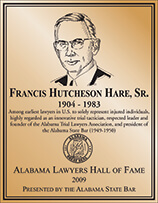 Francis Hare was born in Lower Peach Tree, Alabama, on August 13, 1904. He received his law degree from the University of Alabama and began the practice of law in 1927. Throughout his 56 years as a lawyer, his contributions to the legal profession were tremendous.
Francis Hare was born in Lower Peach Tree, Alabama, on August 13, 1904. He received his law degree from the University of Alabama and began the practice of law in 1927. Throughout his 56 years as a lawyer, his contributions to the legal profession were tremendous.
Mr. Hare was one of the first attorneys in the United States to devote his practice to representing the rights of injured individuals. Behind this commitment was a genuine sensitivity for each client’s personal loss, coupled with a unique ability to present their case with clarity and force. Of his many contributions to civil litigation, three stand out in terms of innovation and influence: first, a complete rethinking of the basis upon which wrongful death claims are made; second, a personal manifesto on the nature of pain and suffering; and third, an argument which brought new respect for the often tragic consequences that so-called “small disabilities” can have upon the quality of an injury victim’s life.
Two other contributions made by Francis Hare were his work in the advancement of the relationship between law and science, for which he was awarded the Gold Medal by the Law-Science Academy of America, and his firm support for the establishment of a Continuing Legal Education program by our state bar association.
Francis Hare was respected by his colleagues. He was elected President of the Birmingham Bar Association, 1942-43, President of the Alabama State Bar, 1949-50, President of the Alabama Trial Lawyers Association, and finally, President of the International Academy of Trial Lawyers. His many writings and over three hundred lifetime speaking appearances earned him the reputation as one of America’s most articulate spokesmen for both the dignity of the legal profession and the importance of all clients’ rights, regardless of race, income, or social standing.
Another titan of the bar, Howell Heflin, himself a 2007 inductee of our Hall of Fame, described Francis Hare as “a rare and unique character, as well as a tremendous trial lawyer. He was widely known for his wit and would often come up with ideas that, at first glance, seemed shocking. Only after careful reflection and close examination would the shock fade away, leaving behind the deep thought, excellent logic, and true merit of his ideas”.
Heflin continued: “There is no question that Francis Hare was a great legal scholar. He had a fine and keen analytical mind. He possessed a perceptive insight, almost beyond belief. His memory was superb, and his integrity beyond reproach. His voice, personality, and manner were all as if tailored to his chosen craft. Together these qualities meshed to make Francis Hare one of the most outstanding trial attorneys of this, or any, era”.
The impact of Mr. Hare’s life was not limited to the law. For nearly six decades he served the Birmingham community through numerous charitable and civic pursuits. Of these endeavors he perhaps took the greatest pride in the Sunday school class he taught for forty years.
Francis Hare died on June 22, 1983. His use of demonstrative aids laid the foundation for many of today’s modern courtroom techniques. His simple and logical arguments painted a clear picture which every juror could understand regardless of their education or station in life. Today the lawyers of Alabama honor Francis H. Hare, Sr. as one of the most prominent courtroom trial lawyers of our Bar and welcome him as a member of the Alabama Lawyers Hall of Fame.
-
James G. Birney (1792 - 1857)
-
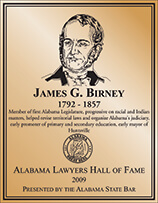 James G. Birney, though a native of Kentucky, played a significant role in the early history of Alabama. He was born in Danville, Kentucky on February 4, 1792, graduated from Princeton University in 1810, and returned to Danville to practice law. In 1816 he was elected to the Kentucky legislature but moved to Huntsville, Alabama in 1818 since he saw Alabama as a place of opportunity.
James G. Birney, though a native of Kentucky, played a significant role in the early history of Alabama. He was born in Danville, Kentucky on February 4, 1792, graduated from Princeton University in 1810, and returned to Danville to practice law. In 1816 he was elected to the Kentucky legislature but moved to Huntsville, Alabama in 1818 since he saw Alabama as a place of opportunity.
Though not a member of the Alabama Constitutional Convention, he was a member of the first state legislature. He helped revise the territorial laws and organized the state judiciary. In his law practice he defended freed slaves and Native Americans when they needed legal representation. Among his other contributions, he founded the Huntsville Library Company, was involved in local education efforts, was appointed solicitor for the Fifth Circuit of Alabama which included Walker, Blount, Morgan, Jackson, and Madison counties, was appointed a Huntsville alderman, elected mayor of Huntsville, and then in 1830 was named to the Board of Trustees of the University of Alabama. All of these activities took place before his 40th birthday.
Birney was also a man of conflicted views. Though he was a slave owner, he became famous for his crusade for racial justice. He favored laws to ensure the humane treatment of slaves. He became involved in the movement to emancipate slaves and became a member of the National Colonization Society of America seeking to reintroduce former slaves to their African heritage. When his views fell out of favor with local residents, he left Alabama in 1833. His opinions evolved over time from colonization to gradual emancipation to immediate emancipation.
In 1840 Birney was nominated as a candidate of the Liberty Party for President of the United States. He only received 7,059 votes that year. However, in one of those circumstances where the man and the moment met, Birney’s presence on a ballot probably changed history.
In 1844 he was again nominated as the presidential candidate of the Liberty Party. This was the year of the very close election between the Democratic candidate, James K. Polk, and the Whig party candidate, Henry Clay, a family acquaintance of Birney’s from Kentucky. In the national popular count Polk received 1,337,243 votes or 49.3% of the total to Clay’s 1,299,062 votes or 48.1%. Birney received 62,300 or 2.3% of the total. In this election, reminiscent of Bush-Gore in 2000, the winning candidate needed 138 electoral votes. Polk had 134. Clay had 105. New York State with 36 electoral votes would decide the election.
New York, like Florida in 2000, was a very close race. Polk received 237,588 votes to Clay’s 232,482, a plurality of 5,106. But Birney had received 15,812. If Birney had not been in the race, and if only one third of his votes had gone to Clay, Clay would have won New York and the presidency. We can only guess how history would have changed. Would there have been a war with Mexico over Texas which Polk advocated and Clay opposed? Would there have been a different policy toward the Oregon Territory? We will never know.
Birney was injured in an accident following a fall from a horse in 1845 and was partially paralyzed. However, he continued to write on political and constitutional issues involving slavery. He died in 1857, prior to the war that would tear the nation apart. Though he lived in Alabama only 15 years, James G. Birney made significant contributions to this state in the areas of government, politics, and education, and he is remembered nationally for his ideas on slavery. The lawyers of Alabama honor him today with induction into the Alabama Lawyers Hall of Fame.
-
Michael A. Figures (1947 - 1996)
-
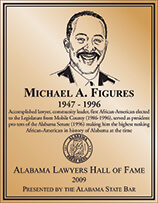 Michael Figures was born in Mobile, Alabama, on October 13, 1947. He graduated from Stillman College in Tuscaloosa in 1969 and served as President of the Student Government Association at the school. He was among the first African American graduates of the University of Alabama School of Law, graduating in 1972.
Michael Figures was born in Mobile, Alabama, on October 13, 1947. He graduated from Stillman College in Tuscaloosa in 1969 and served as President of the Student Government Association at the school. He was among the first African American graduates of the University of Alabama School of Law, graduating in 1972.
Early in his career, Figures practiced public interest law representing the Emergency Land Fund, a group devoted to protecting the rights of Black landowners in the South. He later joined the firm of Crawford, Blacksher, Menefee, and Stein in Mobile. He continued to practice law for a number of years with Vernon Crawford who was a 2008 inductee into the Alabama Lawyers Hall of Fame. In 1981 he established his own firm, Figures, Irby, and Ludgood. The firm’s clients included labor unions, pension funds, small businesses, public entities, and individual clients.
Michael Figures is best known for his participation in the litigation that struck down at-large elections in the City of Mobile, and the lawsuit against the United Klans of America which sought damages for the family of Michael Donald, a 19 year old Black youth, who was lynched in 1981 in Mobile. The case resulted in a multimillion dollar judgment which bankrupted the Klan. He was selected Trial Lawyer of the Year in 1987.
Michael Figures was a past President of the Alabama Black Lawyers Association and was on the Board of Directors of the Legal Services Corporation of Alabama. He was a founding member of the Vernon Z. Crawford Bay Area Bar Association, an association of Black lawyers in Mobile.
While maintaining an active law practice, Figures worked to elect representatives that would be responsive to the needs of under-represented populations in Mobile. In 1978 he himself was elected to the Alabama Senate and he became the first African American Senator from Mobile County. His colleagues selected him as Outstanding Legislator in 1986 and he was elected President Pro Tempore of the Senate in 1996. This achievement made him the highest ranking African American government official in the history of Alabama at that time. He was a founding member and past President of the Alabama New South Coalition, an organization established to strengthen Black political participation throughout the state.
Active in Democratic politics, Figures was elected a delegate to five Democratic Presidential nominating conventions and he served as Treasurer of the Alabama Democratic Party. He also served on the Board of Trustees of his alma mater, Stillman College.
Michael Figures accomplished much in his short lifetime. He died on September 13, 1996, exactly one month shy of his 49th birthday. For his service to his community, his state, and his profession, the lawyers of Alabama honor Michael A. Figures today with induction into the Alabama Lawyers Hall of Fame.
-
Clement C. Clay (1789 - 1866)
-
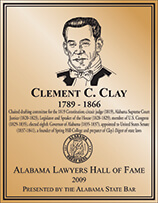 Clement Comer Clay was born in Halifax County, Virginia, on December 17, 1789 and moved to Tennessee as a child. He graduated from East Tennessee College (later the University of Tennessee) in 1807 and was admitted to the bar in 1809. In 1811, he came to Huntsville, then part of the Mississippi Territory, with little money, but a lot of ambition. He served as an adjutant in the 1813 Creek Indian War under General Andrew Jackson.
Clement Comer Clay was born in Halifax County, Virginia, on December 17, 1789 and moved to Tennessee as a child. He graduated from East Tennessee College (later the University of Tennessee) in 1807 and was admitted to the bar in 1809. In 1811, he came to Huntsville, then part of the Mississippi Territory, with little money, but a lot of ambition. He served as an adjutant in the 1813 Creek Indian War under General Andrew Jackson.
Alabama had been part of the Mississippi Territory, but when Mississippi entered the union in 1817, Alabama remained a territory. Clay served in the 1817-1819 Territorial Legislature and also the 1819 Constitutional Convention. At that convention, Clay became chairman of the 15 member committee assigned to draft the constitution that upon approval of the United States government on December 14, 1819, would make Alabama the 22nd state of the Union. Clay was encouraged to run for the office of Alabama’s first governor, but the Constitution stated that the governor must be 30 years of age. Clay was only 29. Instead, he was elected a circuit judge by the new state legislature. The other four circuit judges elected Clay the state’s first Chief Justice.
Clement C. Clay served on the state Supreme Court from 1820-1823. In 1827, he was elected to the Alabama Legislature, where he served as Speaker of the House. In 1829 he was elected to the United States Congress and in that position he helped arrange the 1833 negotiations concerning the removal of the Creek Indians from Alabama.
In 1835, he was elected the eighth Governor of Alabama and during this difficult term of office the removal of the Creek Indians resulted in the Trail of Tears, many Alabamians served in the militia and fought against the Seminoles in Florida, and in 1836, a large number of Alabama citizens were massacred by the Mexican army at Goliad, Texas. Also, in 1836, Clay helped establish Spring Hill College in Mobile, the third oldest Jesuit College in the United States.
In 1837 Clay was appointed by the legislature to the United States Senate and he resigned as Governor. He remained in the Senate until 1841 when he resigned to return to Alabama in order to prepare a digest of state laws under the direction of the Alabama General Assembly. Clay’s Digest, completed in 1843, is still referenced today. In 1843, Clay was appointed to the State Supreme Court by Governor Fitzpatrick to fill a vacancy for six months.
Clay returned to his law practice during the latter years of his life. His son, Clement Claiborne Clay, served as Senator from Alabama from 1853 to 1861. Because the Clays supported secession, the elder Clay was arrested when Huntsville was occupied by Union troops during the Civil War. He died on September 7, 1866.
Clement Comer Clay helped to make Alabama’s first constitution. He served in the legislature, in Congress, and as the state’ first Chief Justice. He authored Clay’s Digest of Alabama Laws. In 1931, a bridge was built over the Tennessee River and named in his honor. His early law office has been restored and is now a part of the Alabama Constitution Village in Huntsville. Today the lawyers of Alabama recognize his many contributions and induct him into the Alabama Lawyers Hall of Fame.
-
Samuel W. Pipes, III (1916 - 1982)
-
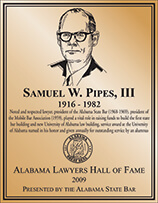 Samuel W. Pipes, III was born in Mobile on February 28, 1916. He was educated in the public schools of Mobile and he graduated from the University of Alabama School of Law in 1938. He then began his law practice in Mobile with the firm of Gordon, Edington, Leighs, and Gordon. He next became an associate in the firm of Lyons and Thomas. He practiced law continuously with that firm and its successors, the firm name becoming Lyons, Pipes & Cook by the time of his death on October 28, 1982.
Samuel W. Pipes, III was born in Mobile on February 28, 1916. He was educated in the public schools of Mobile and he graduated from the University of Alabama School of Law in 1938. He then began his law practice in Mobile with the firm of Gordon, Edington, Leighs, and Gordon. He next became an associate in the firm of Lyons and Thomas. He practiced law continuously with that firm and its successors, the firm name becoming Lyons, Pipes & Cook by the time of his death on October 28, 1982.
Mr. Pipes was a tireless worker for the legal profession. He became President of the Mobile Bar Association. He served the Alabama State Bar as a Chairman of four committees including the Grievance Committee during the time of the Quickie Divorce Scandal, the Committee on Congestion in Appellate Courts, the Committee on Location of the Clerk’s Office in Alabama for the New Circuit Court of Appeals, and the Building Fund Drive of the Alabama Bar Foundation. It was in this important leadership position that Sam Pipes led the campaign to build and pay for the first incarnation of the Bar Association Building on Dexter Avenue in Montgomery.
His skill as an organizer and fundraiser was next applied to his alma mater, the University of Alabama School of Law. He was a Director and then President of the Law School Foundation Board. He became Chairman of the statewide fundraising campaign which laid the groundwork for establishing the Farrah Law Society at Alabama, named for Dean Albert Farrah, a 2004 inductee of our Hall of Fame, and which ultimately culminated in the new law school at Tuscaloosa. The lawyers of the state honored him by selecting him as President of our association for the 1968-69 term of office.
He continued to serve the Bar in many other capacities over the years. He authored publications in the field of Oil and Gas Law. He volunteered to serve on Supreme Court committees and even had the honor of serving as a Special Justice of the Alabama Supreme Court.
In civic and business affairs, Sam Pipes served as Treasurer of Mobile’s All Saints Episcopal Church, General Counsel of the Mobile Area Boy Scouts, Director of the Commercial Guaranty Bank of Mobile, and Director of the Title Insurance Company of Mobile.
In appreciation for his tireless efforts at fundraising for the University of Alabama Law School, the school established an annual award for its outstanding alumnus of the year. It is the most prestigious award bestowed by the Law School to a graduate and this ceremony is the highlight of the annual Farrah Law Society banquet. The award is named the Sam W. Pipes Distinguished Alumnus Award. Sam Pipes was an outstanding lawyer and leader. We honor him today with induction into the Alabama Lawyers Hall of Fame.
 Francis Hare was born in Lower Peach Tree, Alabama, on August 13, 1904. He received his law degree from the University of Alabama and began the practice of law in 1927. Throughout his 56 years as a lawyer, his contributions to the legal profession were tremendous.
Francis Hare was born in Lower Peach Tree, Alabama, on August 13, 1904. He received his law degree from the University of Alabama and began the practice of law in 1927. Throughout his 56 years as a lawyer, his contributions to the legal profession were tremendous. James G. Birney, though a native of Kentucky, played a significant role in the early history of Alabama. He was born in Danville, Kentucky on February 4, 1792, graduated from Princeton University in 1810, and returned to Danville to practice law. In 1816 he was elected to the Kentucky legislature but moved to Huntsville, Alabama in 1818 since he saw Alabama as a place of opportunity.
James G. Birney, though a native of Kentucky, played a significant role in the early history of Alabama. He was born in Danville, Kentucky on February 4, 1792, graduated from Princeton University in 1810, and returned to Danville to practice law. In 1816 he was elected to the Kentucky legislature but moved to Huntsville, Alabama in 1818 since he saw Alabama as a place of opportunity. Michael Figures was born in Mobile, Alabama, on October 13, 1947. He graduated from Stillman College in Tuscaloosa in 1969 and served as President of the Student Government Association at the school. He was among the first African American graduates of the University of Alabama School of Law, graduating in 1972.
Michael Figures was born in Mobile, Alabama, on October 13, 1947. He graduated from Stillman College in Tuscaloosa in 1969 and served as President of the Student Government Association at the school. He was among the first African American graduates of the University of Alabama School of Law, graduating in 1972. Clement Comer Clay was born in Halifax County, Virginia, on December 17, 1789 and moved to Tennessee as a child. He graduated from East Tennessee College (later the University of Tennessee) in 1807 and was admitted to the bar in 1809. In 1811, he came to Huntsville, then part of the Mississippi Territory, with little money, but a lot of ambition. He served as an adjutant in the 1813 Creek Indian War under General Andrew Jackson.
Clement Comer Clay was born in Halifax County, Virginia, on December 17, 1789 and moved to Tennessee as a child. He graduated from East Tennessee College (later the University of Tennessee) in 1807 and was admitted to the bar in 1809. In 1811, he came to Huntsville, then part of the Mississippi Territory, with little money, but a lot of ambition. He served as an adjutant in the 1813 Creek Indian War under General Andrew Jackson. Samuel W. Pipes, III was born in Mobile on February 28, 1916. He was educated in the public schools of Mobile and he graduated from the University of Alabama School of Law in 1938. He then began his law practice in Mobile with the firm of Gordon, Edington, Leighs, and Gordon. He next became an associate in the firm of Lyons and Thomas. He practiced law continuously with that firm and its successors, the firm name becoming Lyons, Pipes & Cook by the time of his death on October 28, 1982.
Samuel W. Pipes, III was born in Mobile on February 28, 1916. He was educated in the public schools of Mobile and he graduated from the University of Alabama School of Law in 1938. He then began his law practice in Mobile with the firm of Gordon, Edington, Leighs, and Gordon. He next became an associate in the firm of Lyons and Thomas. He practiced law continuously with that firm and its successors, the firm name becoming Lyons, Pipes & Cook by the time of his death on October 28, 1982.